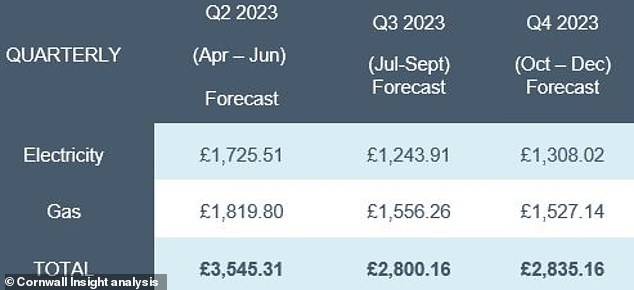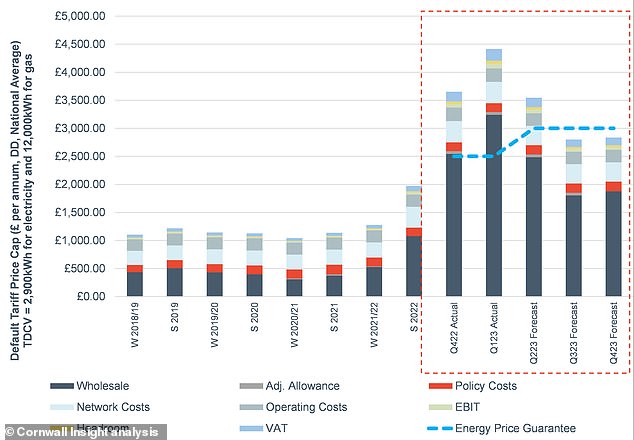Energy bills could fall below £3,000 a year from July
>
Utility bills fall below £3,000 a year from July but remain ‘significantly above’ pre-pandemic levels, analysts say
- The utility bill will be £2,800 a year from July, Cornwall Insight claims
- In effect, EPG will no longer be a cost to the government, the report suggests
<!–
<!–
<!–<!–
<!–
<!–
<!–
The energy bill for an average household is expected to fall under the government’s energy price guarantee from July this year, experts from Cornwall Insight say.
However, utility bills will remain ‘significantly above’ pre-pandemic levels, to stand at around £2,800 for the second half of the year, which is £300 more than the current capped EPG rate of £2,500.
Declining wholesale energy prices are the main driver behind the predicted decline in the cap forecast, added Cornwall Insight, an energy market analyst.

What’s next? From July this year, energy bills are expected to be below the government’s energy price guarantee, according to Cornwall Insight experts
It added: ‘These declines will not have their main effects until the third quarter of 2022, as energy suppliers typically purchase (hedging) their energy in advance to meet the limit.
“This means that falling daily wholesale prices (spot prices) have a limited impact in the short term.”
> Why it may take some time for falling gas prices to show up in our bills
In October, Cornwall Insight predicted that energy bills could rise to more than £4,000 a year by April 2023.
With the EPG currently set to rise to £3,000 a year from April, if the price cap eventually falls below the prevailing EPG level, the support scheme will effectively cease to be a cost to the government as we enter the second half of the year. the year, according to Cornwall Insight experts.
Despite the reduction in the price cap, the total cost of the EPG to the government for the period to 31 March 2024 is still estimated to be around £37 billion.
This is ‘money that should be recovered through the taxpayer’, according to Cornwall Insight.


Forecasts: Cornwall Insight Standard Fare Limit Forecasts for 2023
Dr. Craig Lowrey, lead adviser at Cornwall Insight, said: ‘While it is positive to see a fall in the price cap forecast, household bills will remain high.
With the Energy Price Guarantee rising in April, a typical household will still face bills well above historic levels in the second half of the year and costs many cannot afford.
“If the limits fall below the threshold of the EPG, if wholesale prices remain at this level, the scheme will effectively no longer cost the government.
“We need to remain cautious as the government has essentially ensured a volatile wholesale energy market – one that is likely to remain volatile throughout the year.


Then and now: chart showing standard rate cap levels since 2018 and Cornwall Insight’s predictions for the next three cap increases
“Even if energy prices remain at current levels – which is a big if – the cost to government over the full EPG period will still add to government borrowing and will eventually pay off in the form of higher taxes on the feet of the public. fall consumer. ‘
He added: “The government has indicated its intention to reform the energy market, including a review of domestic energy prices.
It is clear that blanket bill support measures do not provide adequate protection for the most vulnerable and more targeted measures, including social tariffs, may be something for the government to consider.
While the details of future support are best left to the discretion of politicians, the projections show that we need to look beyond current policies if we are to see a fairer, more cost-efficient and sustainable way of reducing household energy bills. for those who need it most.’
The current energy price cap is £4,279 per annum and will soon be reviewed again for the April to June period.
While households are protected by the EPG, the ceiling still reflects the cost of energy supply and will be used by the government to establish the guarantee.
The Energy Bills Support Scheme, which gives households a grant of £400 to help with their energy bills during the winter, expires in April. Payments have been made monthly since October, the last in March.
Energy bills were the biggest shock to many households last year, as wholesale gas prices skyrocketed following Russia’s invasion of Ukraine.

